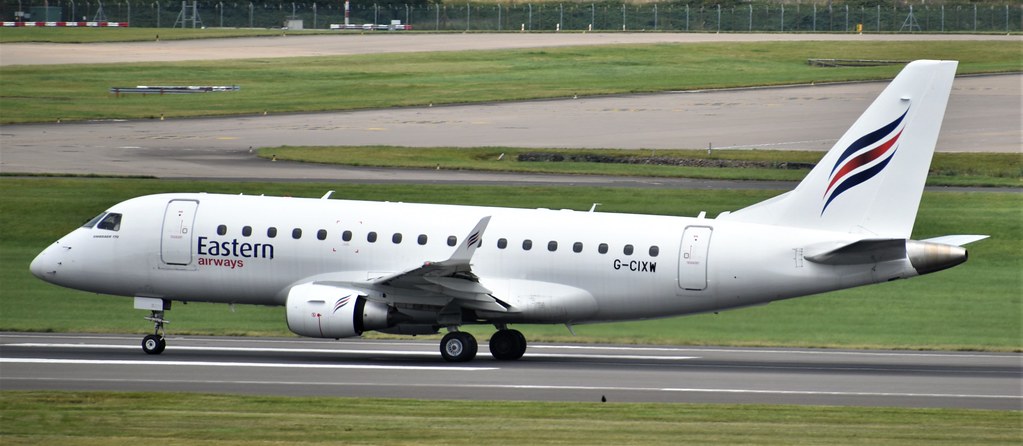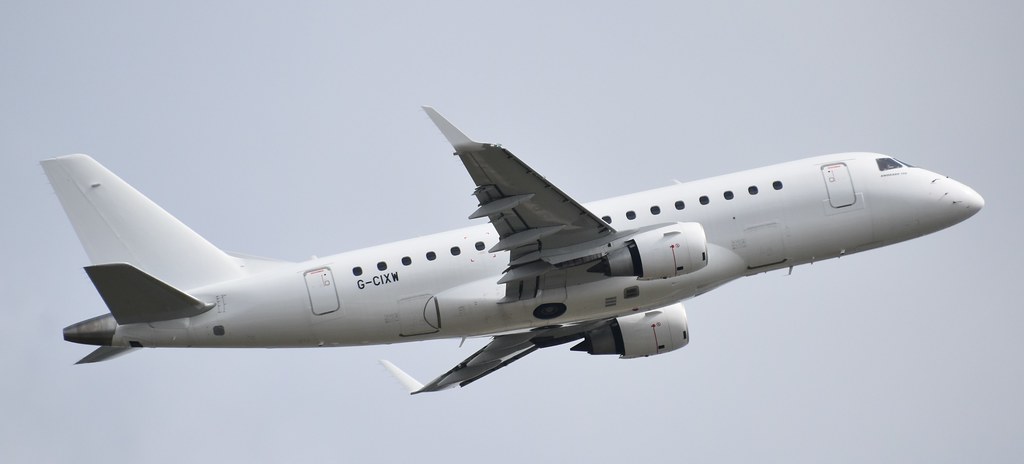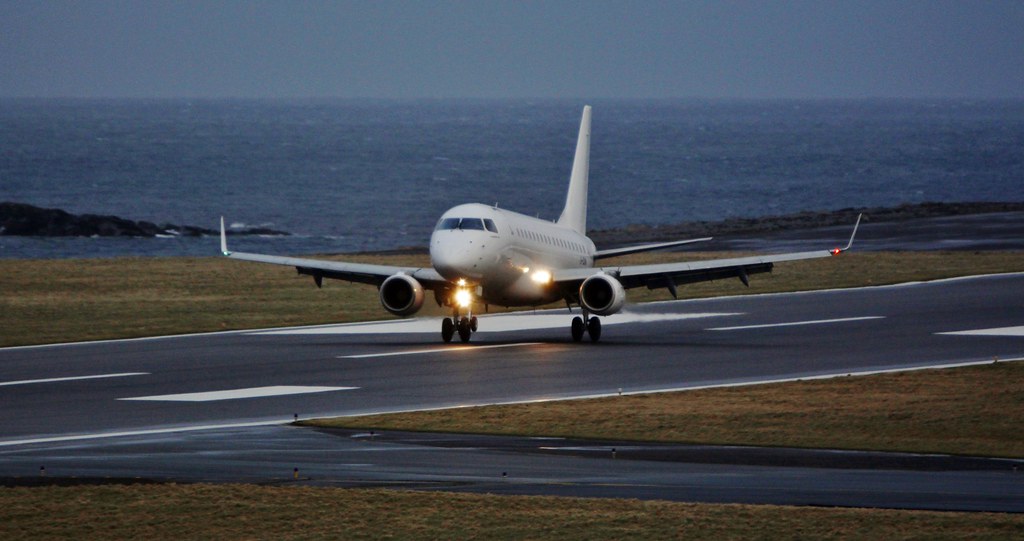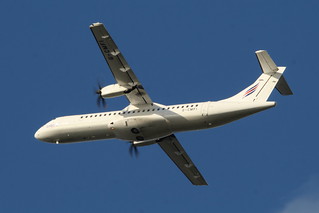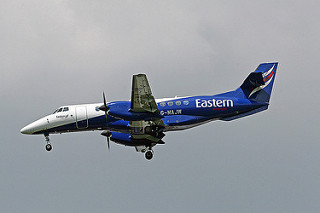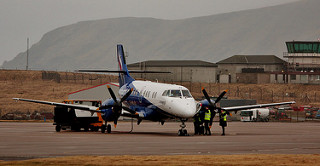Eastern Airways E170 at Birmingham on Jun 7th 2021, trim, autopilot and steering failure
Last Update: October 13, 2022 / 14:16:19 GMT/Zulu time
Incident Facts
Date of incident
Jun 7, 2021
Classification
Report
Airline
Eastern Airways
Flight number
T3-975
Departure
Gibraltar, Gibraltar
Destination
Birmingham, United Kingdom
Aircraft Registration
G-CIXW
Aircraft Type
Embraer ERJ-170
ICAO Type Designator
E170
On Oct 13th 2022 the AAIB released their bulletin concluding the probable causes of the serious incident were:
The failure of the pitch trim system probably occurred because of jamming of the horizontal stabiliser as a result of freezing of water ingression in the ball nut due to condensation. The investigation found that the operator had lubricated the horizontal stabiliser at the intervals specified by the manufacturer to prevent such an occurrence.
Jamming of the horizontal stabiliser resulted in the loss of the pitch trim functionality. Consequently, the PF experienced greater than normal nose-down pitch forces on the approach. The PF delegated the monitoring of the throttles, which were still in autothrottle, to the PM to allow him to use both hands on the yoke. The PF flew a stable approach and made a safe landing. However, on landing, the steer fail caution illuminated, as a result of an unrelated sensor failure. The commander took control and brought the aircraft to a safe stop and taxied the aircraft to stand using differential braking.
The AAIB analysed:
The fixed position of the horizontal stabiliser was probably caused by the jamming of the ball nut due to the freezing of water ingress, itself probably the result of condensation. Although examination of the HS-ACE only identified a single channel failure, this condition alone should not prevent the surface movement as the channels are automatically switched after the failure of one channel. (The system is designed so that only one HS-ACE channel is active at a time and is able to command the system). Since the HSTAB was fixed, the active channel was not able to command any movement. After switching, the standby channel became active but could not command movement as well for the same reason. This condition resulted in the loss of pitch trim functionality and illumination of the PITCH TRIM FAIL caution.
The disengagement of the AP by the PF, even though this is not required by the relevant procedure, addressed the hazard of a more potentially serious trim condition of a pitch trim runaway. AP trim functionality, indicated by the illumination of the ap fail caution, would not have been available owing to the pitch trim failure.
Failure probably resulted in the HSTAB being stuck at -2.4°, (and that the two occasions, where -2.4° was recorded, were the result of the crew completing the actions which required the de-selection and re-selection of the pitch trim cut-out switches as part of the pitch trim failure procedure.) The consequence of the stabiliser being stuck was that the PF experienced heavier nose-down forces in pitch than would be normal, requiring stronger than normal pilot inputs to maintain the correct pitch attitude for the approach. The decision by the pilots that the PM would monitor the throttles, which were in autothrottle, to enable the PF to place both hands on the yoke to control pitch attitude, gave the PF the control to make the required pitch changes. The approach subsequently flown was stable and resulted in a safe landing.
The investigation found that the operator had lubricated the HSTAB in accordance with the recommended intervals, which were intended to prevent such an occurrence, as specified by the manufacturer.
The steer fail caution was triggered by a sensor failure. This resulted in the loss of steering through the pedals (and the handwheel) which required the PF to steer the aircraft in free wheel mode using differential braking.
The pitch trim fail and steer fail cautions were unrelated. The nature of the failures, affecting control both in the air and the ground, together with the flt ctrl no dispatch CAS message required further action by the operator before the aircraft could be declared serviceable, necessitating an entry in the aircraft technical log by the commander.
Incident Facts
Date of incident
Jun 7, 2021
Classification
Report
Airline
Eastern Airways
Flight number
T3-975
Departure
Gibraltar, Gibraltar
Destination
Birmingham, United Kingdom
Aircraft Registration
G-CIXW
Aircraft Type
Embraer ERJ-170
ICAO Type Designator
E170
This article is published under license from Avherald.com. © of text by Avherald.com.
Article source
You can read 1 more free article without a subscription.
Subscribe now and continue reading without any limits!
Read unlimited articles and receive our daily update briefing. Gain better insights into what is happening in commercial aviation safety.
Send tip
Support AeroInside by sending a small tip amount.
Related articles
Eastern Airways AT72 at Newquay on Apr 15th 2025, flaps problems
An Eastern Airways Avions de Transport Regional ATR-72-212A. registration G-IACZ performing flight T3-458 from London Gatwick,EN to Newquay,EN (UK),…
Eastern Airways AT72 at Leeds on Oct 9th 2022, fumes in cockpit
An Eastern Airways Avions de Transport Regional ATR-72-212A, registration G-CMFI performing flight T3-9634 from London Biggin Hill,EN to Leeds,EN…
Eastern Airways AT72 near Exeter on Jan 7th 2023, cracked windshield
An Eastern Airways Avions de Transport Regional ATR-72-212A, registration G-CMFI performing flight T3-456 from London Gatwick,EN to Newquay,EN (UK),…
Eastern Airways JS41 at Sumburgh on Feb 27th 2018, unsafe nose gear
An Eastern Airways BAe Jetstream 41, registration G-MAJW performing flight T3-1035 from Aberdeen,SC to Shetland Islands Sumburgh,SC (UK) with 18…
Eastern Airways JS41 at Aberdeen on Jun 27th 2018, bird strike
An Eastern Airways BAe Jetstream 41, registration G-MAJU performing flight T3-1035 from Aberdeen,SC to Shetland Islands Sumburgh,SC (UK) with 17…
Newest articles
Eastern Airways AT72 at Newquay on Apr 15th 2025, flaps problems
An Eastern Airways Avions de Transport Regional ATR-72-212A. registration G-IACZ performing flight T3-458 from London Gatwick,EN to Newquay,EN (UK),…
India B788 at Ahmedabad on Jun 12th 2025, lost height shortly after takeoff, no thrust reported
An Air India Boeing 787-8, registration VT-ANB performing flight AI-171 from Ahmedabad (India) to London Gatwick,EN (UK) with 230 passengers and 12…
Subscribe today
Are you researching aviation incidents? Get access to AeroInside Insights, unlimited read access and receive the daily newsletter.
Pick your plan and subscribePartner

ELITE Simulation Solutions is a leading global provider of Flight Simulation Training Devices, IFR training software as well as flight controls and related services. Find out more.
SafetyScan Pro provides streamlined access to thousands of aviation accident reports. Tailored for your safety management efforts. Book your demo today
AeroInside Blog
Popular aircraft
Airbus A320Boeing 737-800
Boeing 737-800 MAX
Popular airlines
American AirlinesUnited
Delta
Air Canada
Lufthansa
British Airways
